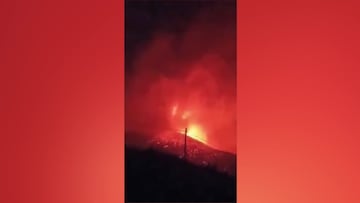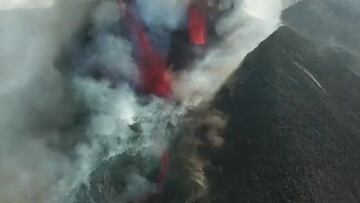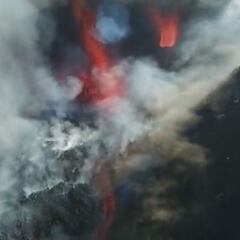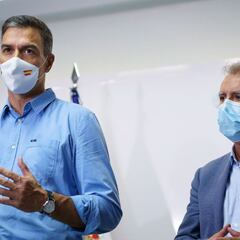Spanish volcanologist explains what will happen when the lava reaches the sea on La Palma
Vicente Soler, volcanologist of the CSIC, answers all our questions about the eruption on La Palma in an interview with AS.


The eruption of the volcano of La Palma continues, with strong explosions that have amazed neighbors and tourists who have witnessed the phenomenon. Currently, one of the lava flows has stopped, while the other is slowly advancing down the slope towards the sea, a place where it is not yet clear if it will reach. In the last hours there was a strong eruption which created a third lava flow.
One of the experts who has been following the volcano of La Palma closely, very close to it, is Vicente Soler, volcanologist of the Spanish National Research Council (CSIC), who has been interviewed by AS to explain the current situation of the volcano, how the process began and what is expected for the future.
Question: How did the volcano arise?
Answer: Doing a little history, it began in October 2017 with a small earthquake 20 kilometers deep. These rumbles were repeated during 2018-2019 and on September 11, 2021 an earthquake appeared at a depth of 10 kilometers. Then, the magma found a route which allowed it to rise silently, without a quake. On this day the first surge occurred, a little south of where the volcano is, the seismic effort pushed the magma to shallower depths, so that it broke from the 11th to the 19th, when at 15:10 the process began.
Q. Has the lava come out of an unexpected place?
A. The seismic activity, which is monitored by the National Institute for Geography (IGN), pointed out that the magma was moving towards the north and the surface. In fact, on Sunday morning at 10:00 there was an earthquake of about 4 degrees of magnitude which is the one that really opened the way to the volcano. Five hours later the eruption took place.
Q. How many mouths does the volcano have?
A. The eruption started with a single outlet. It opened up to seven or new vents that quickly converge in two or three. The important thing to note is that the eruptive environment is the same and it is important to keep it that way. It doesn't matter if a mouth opens 50 meters forward or backward, the lava channel through which it flows is maintained for the time being.
Q. What stage is the volcano at?
A. It should be noted that the lava flow front that is in front of the church of Todoque has almost stopped because all the effort is going into what they call the southern lava flow, which is nothing more than a diversion of the main lava flow that seems to be advancing slowly. It is going to keep slowing down. If it is not able to connect with the main flow, it will not feed it and it will continue its course toward the sea.

P. We have seen firefighters trying to redirect the flow into a gully. Is this possible?
A. Lava is a non-Newtonian fluid, so it is difficult for it to respond to small slopes. Of course it responds easily to large slopes and can be channeled, but it has to be a ravine of certain dimensions. In this case, the idea is to make a 'gully' so that it does not damage the church. As the magma becomes more viscous and cools down, it is more difficult, although the possibility exists.
Q. Is the possibility of the lava reaching the sea still being considered?
A. On an island like this one, which has such steep slopes towards the sea, the likely scenario is always that it will reach the sea. Whether there is enough lava flow to do so is another matter, because as the lava flow occupies more surface area, it is more difficult for it to advance. Besides, as it cools down a bit, it becomes more viscous and focuses more on growing than advancing.
Q. What would happen if it came into contact with the sea?
A. Basically, a large column of water vapor is produced and the advance is practically the same as on land. That is to say, the cold part breaks up and is detached by the thrust of the hot part and fills the bottom creating a platform.
Q. What can you tell us about the type of eruption?
A. It started at 3:10 p.m. with an eruption that alerted everyone. The lava followed, so there was enough time to clear and evacuate the area properly. On Sunday night, it was a real lava fountain rather than a Strombolian eruption. After a few hours, it did acquire its usual patterns characterized by rhythmic activity. Today, the activity is strong because the deformation of the terrain remains intact, i.e. the pressure in the system feeding the volcano is very high.

Q. How long can an eruption like this last?
A. Involcan is trying to determine on the basis of SO2 (sulfur dioxide) an estimate of the volume at stake. From there we will be able to say something. At the moment we are in the fourth day and no eruption of La Palma before has lasted less than 24 hours.
Q. What are your personal feelings about this phenomenon?
A. It is always a bittersweet sensation because of the drama of the material damages, especially the houses that have been. The phenomenon itself is worth it, but never at the cost of that material damage. Fortunately, no people have been killed.
Q. What do you think of the criticisms about the location of the houses in the Canary Islands?
A. The islands are totally volcanic and this part is of recent volcanism. In my opinion, what happens is that here, unfortunately, the eruption period is every 40 years and that is a long time. If it were shorter, the memory would be more immediate and the risk areas would be avoided. But that happens here, around Vesuvius and anywhere with volcanoes that have a slow eruption rate.
Q. Have we learned anything from this new eruption?
Related stories
A. From the scientific point of view, this is the first eruption that is properly monitored, with the proper instrumentation. In 1949 and 1971 it was not possible, so it is an experience that will be useful for the following ones. The surprise has been the speed with which the phenomenon has been triggered, but there is no other way to learn than by making mistakes.
Original interview by Santi Castañeda.

